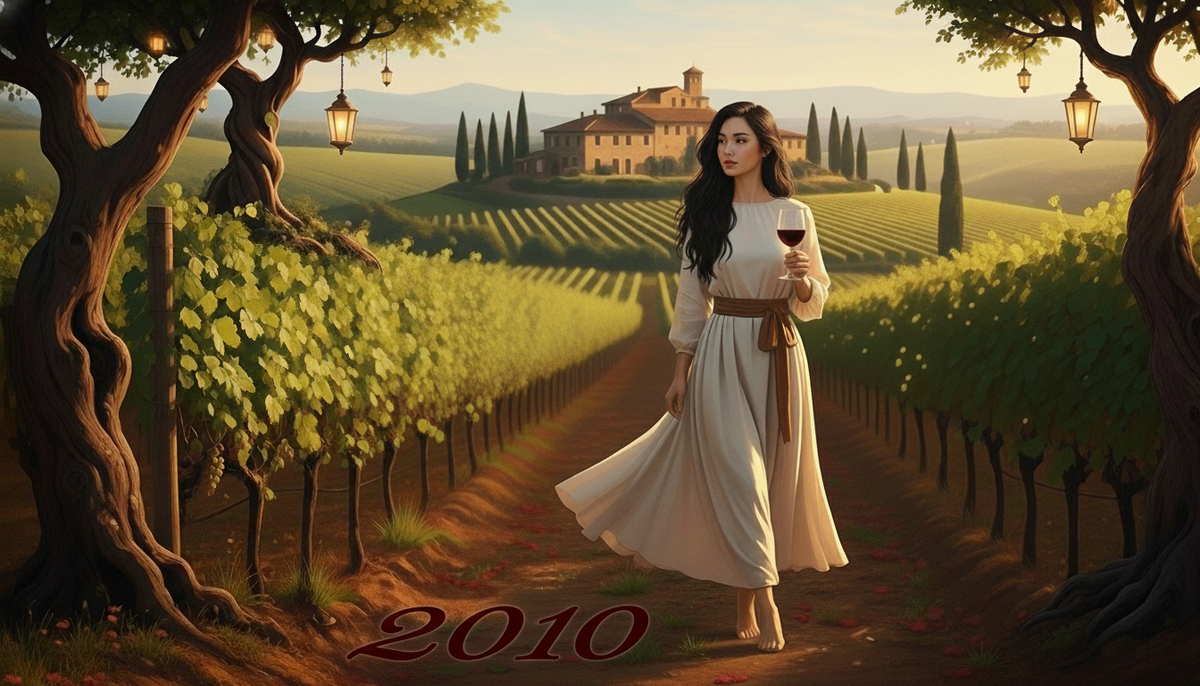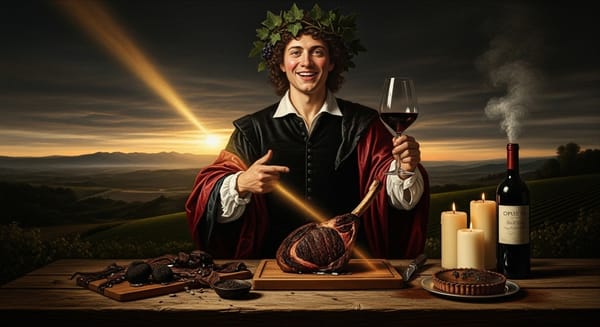2010 Brunello di Montalcino: The Year of the Quiet Sun That Bottled Tomorrow
The 2010 Brunello di Montalcino is a classic. Chang’e explores this legendary vintage, defined by singing acidity, fine tannins, and decades of aging potential. This powerful, poised Sangiovese embodies Montalcino's grace. Essential reading for collectors seeking the perfect balance.

Wild cherry sketched on cool clay under the high, slow light of September. Does a wine, like a person, carry the memory of its childhood weather?
The Long, Measured Arc of the Sun
The Brunello di Montalcino 2010 vintage was a study in patience, a year where nature wrote the script slowly and with elegant restraint. The season began cool, the spring rains measured, lending a necessary humidity to the soil after a dry winter. Flowering was unhurried, giving rise to perfectly spaced, loose clusters. A temperate summer followed, largely spared from heat spikes, though the essential magic came from the profound diurnal shift—warm, sun-drenched days yielding to strikingly cool, high-altitude nights that preserved acid and perfume in the grapes. This long, gentle arc stretched deep into a luminous September and early October. The Sangiovese Grosso had all the time in the world to polish its tannins, deepening color and flavor without rushing to high sugar. Growers walked their parcels, waiting for that precise moment when the seeds were brown and the skins perfectly supple, a high-stakes gamble on ripeness achieved with line, perfume married to poise.
The Architecture of Endurance
The 2010 vintage stands as one of the great successes of modern Brunello, a beautiful counterpoint to the more sun-drenched years that immediately preceded it. It delivered ripeness without heaviness, a delineated structure defined by classic, singing acidity and firm yet utterly fine-grained tannins. This is a vintage that speaks of its place—the high-altitude, wind-brushed clarity, the diverse mix of galestro (a friable marl that drains fast and keeps roots honest), alberese (limestone-rich stone), and clay that yields site transparency. The exceptional diurnal range and the producers' discipline in picking at optimal phenolic ripeness are the twin engines of its remarkable longevity. The question "Is 2010 Brunello worth aging?" is met with a resounding yes: this wine has the structure of an architect’s drawing, designed to unfold across decades.
A Cool Core of Cherry and Leaf
To raise a glass of 2010 Brunello is to feel the air cool around a core of luminous red fruit. The primary flavors are a beautiful counterpoint, ranging from the bright tension of sour cherry and blood orange oil to the plush depth of ripe red plum. But the true story lies in the tertiary and savory elements: notes of worn leather, cured tobacco leaf, sun-dried fennel seed, and a whisper of Earl Grey tea. The temperature of the wine feels controlled, a cool core that belies its concentration, as if the sun’s warmth was distilled but never burned. The texture is the thing of wonder: tannins begin as a subtle, mouth-coating powder, then resolve into a structure as distinct and stone-detailed as the Montalcino hillside itself. The wine is a bell tone held in oak air, clear, resonant, and tapering to a seemingly endless silence. Our friend, Sangiovese, clears its throat with citrus and then speaks in cherry and leaf, carrying the weight of the land with quiet assurance.
The Compass of the Hillside
The magic of Brunello lies in its topographical sprawl, and 2010 highlighted these differences in sharp relief.
North & Northeast (Montosoli, Canalicchio): These wines possess a headline trait of lifted perfume and ethereal grace. Cues include a high-toned red berry line and a fine, chalky grip, reflecting the cooler sites and higher percentage of galestro. They taste of cool, clean light.
East (Torrenieri, Castelnuovo dell’Abate heights): Here, we find pure red-fruited clarity woven through with a savory tea note. The structure is often marked by a pronounced limestone thread, lending energy and a focused persistence.
South & Southwest (Sant’Angelo in Colle, Camigliano): Wines from this slightly warmer exposure offer darker cherry and plum, wrapped in warmer spice notes like cinnamon and star anise. They possess broader, more muscular frames that close with a steady, grounding mineral anchor.
Southeast (Castelnuovo dell’Abate, Pianrosso area): These are the wines of iron-tinged depth. They offer complex secondary notes of incense and deep earth, showing remarkable concentration without sacrificing freshness, leading to the longest, most meditative finishes.
Town/Center Slopes: These tend toward the Brunello archetype—a beautiful balance between aromatic complexity and structural presence, with a clear note of cedar and an even, deliberate stride.
The dark horse of the vintage were those higher, wind-brushed parcels, often facing north or west, that bottled extra nerve and coiled tension in their fine acidity.
The Hand of the Vintner
The 2010 vintage offered winemakers a canvas of excellent raw material, allowing their choices in the cellar to act as mere punctuation marks on a nearly complete story. Fermentation temperatures were largely measured, aimed at gentle extraction to avoid coarseness. Maceration lengths ranged from shorter, precise contact for bright fruit clarity to longer, deliberate infusions that built depth of color and the satiny texture of the fine tannins. The choice of vessel further mapped the wine’s style: large, neutral Slavonian botte (traditional, enormous oak casks) supported the classicists, emphasizing purity and texture, while a judicious use of smaller French barrique (225-liter barrels) lent a delicate spice and polished the grain. Every wine adhered to the required minimum elevage (aging period) of two years in oak and four months in bottle before release, but the how determined the final flavor. The best producers used these techniques—a bit of partial whole-berry inclusion for freshness, slightly varied ABV (alcohol by volume) between 13.5% and 14.5%—not to impose a style, but to keep the terroir audible, to ensure the land sings over the wood.
Voices from the Hilltop
The overall quality of 2010 makes selecting favorites a pleasure, but certain wines captured the year’s clarity with particular brilliance.
Icons: Producers who embody the long-view, high-altitude perspective. Biondi-Santi: delivers pristine classicism and a crystalline acid backbone, a definition of Montalcino grace. Il Poggione: an estate that marries scale with perfect balance, offering power without heat. Poggio di Sotto: sought for its ethereal texture and captivating aromatic intensity, it tastes like tradition distilled. Fuligni: consistently shows the elegance of the northeastern slopes, characterized by fine-boned structure and brilliant perfume.
Value Plays: Wines that outperform their price bracket, reflecting the vintage’s generosity. Col d’Orcia: reliable depth and savory focus at scale, capturing the warmer southern personality. Lisini: delivers an iconic, traditionally structured Brunello with a distinct, grounding mineral complexity. Caparzo: offers authentic, site-true expression across its diverse sub-zones. La Gerla: generous, pure fruit married to a finely etched structure.
Wild Cards: Smaller growers and boundary-pushers who captured 2010’s nerve. Le Ragnaie: prized for its high-elevation purity and nervy, chalky tension, a taste of cool air. Salicutti: intense, site-true elegance from a small grower, known for layered perfume and transparency. Le Chiuse: fine-boned, aristocratic classicism with a long track record of graceful aging. Casanova di Neri: known for its polished, deep fruit and modern precision, yielding a seductive power.
The Unfolding Map of Time
The 2010 is a wine for the long haul, built on a foundation of electric acidity and fine, patient tannin.
Early Charm (Now–2028): These wines are showing beautiful secondary complexity but still require a good two-hour decant to smooth the still-firm structure. You're enjoying the vibrant fruit and spice now, with the energy of the vintage in full display.
Sweet Spot (2029–2042): This is the era of supreme harmony. The primary fruit softens into tertiary elegance—forest floor, worn leather, tobacco—while the acidity holds the whole structure aloft like a perfectly tensioned wire. Open gently, serve cool.
Marathon (2043+): The best bottles, particularly those from high-altitude or clay-rich sites, will evolve into profoundly complex wines, defined by texture and haunting savory complexity, demonstrating how acidity and fine tannin are the true drivers of longevity.
A Final Word on Grace
The 2010 Brunello is an unforgettable classic: a powerful, poised journey bottled with immense potential. It captured the essence of Montalcino in perfect balance. This is a vintage that defines the greatness of Sangiovese Grosso, proving that patience is a virtue you can drink for decades.





